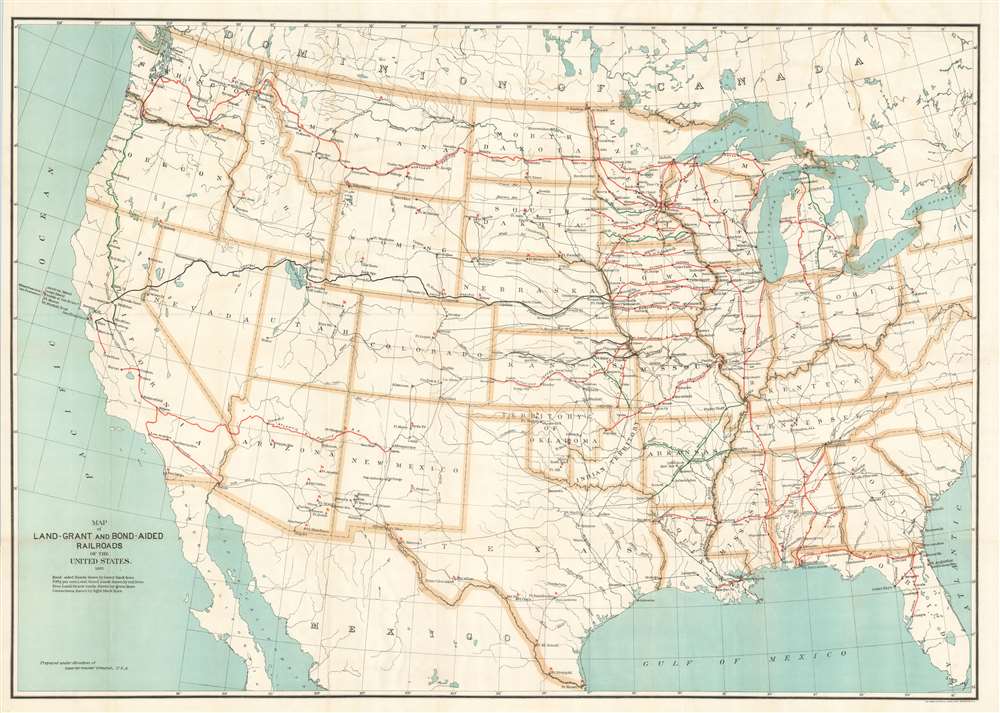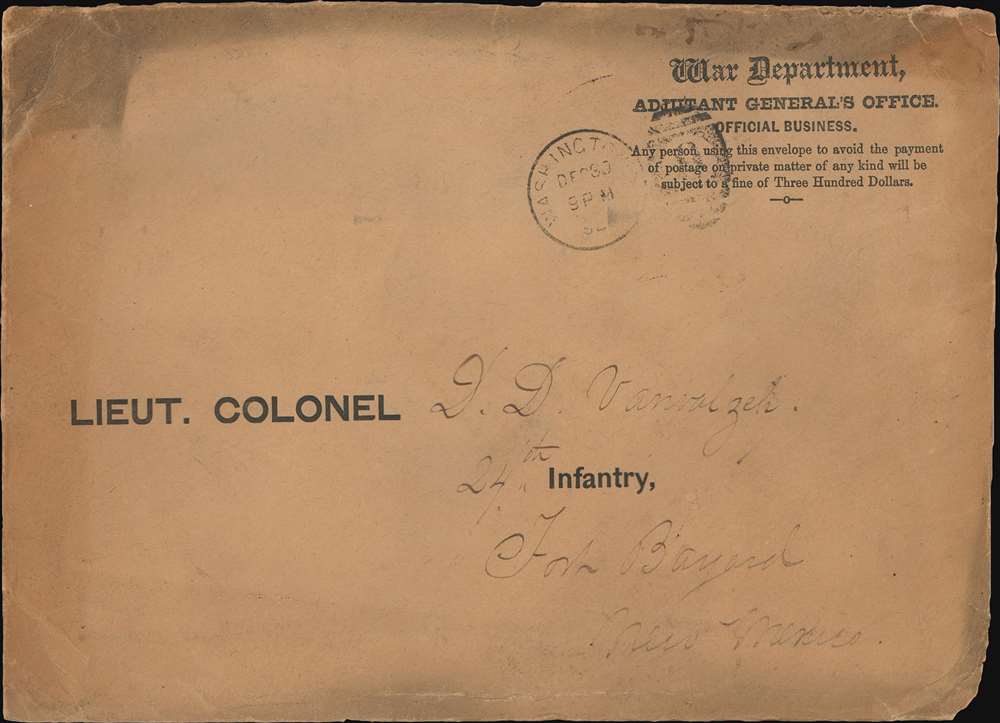This item has been sold, but you can get on the Waitlist to be notified if another example becomes available, or purchase a digital scan.
1892 U.S. Army QMG Railroad Map of United States
LandGrantRailroads-qmg-1892
Title
1892 (dated) 27.5 x 38.5 in (69.85 x 97.79 cm) 1 : 4500000
Description
As an aid to a clear and convenient understanding of the routes, termini, etc., of the several railroads to which this order refers, and as a matter of ready reference, when the use of these roads is involved in the issue of transportation, a map of the land-grant and bond-aided roads is published herewith.
Colonel David Dougall Van Valzah
Colonel David Dougall Van Valzeh (January 5, 1840 - April 22, 1919) was a career officer in the U.S. Army. Born in Illinois, Van Valzeh enlisted in the Union Army at the age of twenty-one on May 14, 1861, and was commissioned as a 1st Lieutenant. Van Valzeh was captured by the Confederates on May 5, 1864, the first day of the Battle of the Wilderness, and was imprisoned at Macon, Georgia, and Columbia, South Carolina. He was paroled on December 12, 1864. After the end of the Civil War, Van Valzeh stayed in the U.S. Army and was promoted to captain, major, and eventually lieutenant colonel. At one point, he was offered the position of commander of the Army officers' school at Fort Leavenworth, Kansas, since he was considered one of the army's best tacticians. For unknown reason, he declined the posting. He was stationed in the American West during the 1880s and 1890s, where he served at Fort Assiniboine, Montana, with the 20th Infantry Regiment, which he eventually commanded. He was then transferred to Fort Bayard, New Mexico, where he commanded the 24th Infantry Regiment, one of the famed Buffalo Soldier units. By 1897, Van Valzah was in command of the 18th Infantry stationed at Fort Bliss, Texas. During the Spanish-American War, Colonel Van Velzah commanded the 18th Infantry Regiment at Iloilo in the Philippines. While fighting in the Manila campaign, Van Valzah's health deteriorated, and he applied for retirement. Van Velzah was discharged on June 20, 1899. He died in Lewistown, Pennsylvania, on April 22, 1919, of 'senility' and 'senile dementia' at seventy-nine.The 24th Infantry Regiment and the Buffalo Soldiers
'Buffalo Soldier' was a nickname originally given to Black Cavalry of the 10th Cavalry Regiment by the Native Americans that fought them during the Indian Wars. Eventually, the term became synonymous with all the Black regiments formed in 1866. The 24th Infantry Regiment was formed on November 1, 1869, and all enlisted soldiers were black and were either veterans of the U.S. Colored Troops or freedmen. The 24th Infantry served in the western United States until 1898 when the regiment was deployed to Cuba.Publication History and Census
This map was prepared under the direction of the Quartermaster General of the United States Army and printed by Norris Peters in 1892. The OCLC catalogs a dozen examples in institutional collections across the United States.Cartographer
Norris Peters (c. 1834 – July 15, 1889) was a Washington D.C. based photo-lithographer active in the late 18th and early 19th century whom Scientific American called 'one of Washington's most eccentric and mysterious figures.' Peters was born and educated in Pennsylvania. He relocated as a young man to Washington D.C. where he took work as an examiner for the United States Patent Office. During his work with the patent office he became fascinated with the emergent process of photolithography. In 1869 Peters secured substantial venture capital of about 100,000 USD from an unknown investor and founded The Norris Peters Company at 458 Pennsylvania Avenue. Their printing offices have been described as 'unequaled in this or any other country.' From these offices Peters pioneered the development of American photo-lithography. For nearly a generation he held a near monopoly on government photo-lithographic printing. Among their more notable contracts included numerous maps for congressional reports, maps of the U.S. Coast Survey, maps of the U.S. Geological Survey, Mexican currency for the State of Chihuahua, and the Official Gazette of the Patent Office. Peters also maintained an interesting social life and was a confidant to many of the most powerful figures in Congress. He was also a bon vivant known for being an excellent cook and hosting lavish dinners, the invitations to which were 'never declined'. Despite being socially active he never married and died a confirmed bachelor. Following Peters' death in 1889 his business was taken over by Henry Van Arsdale Parsell who administered it until his own death in 1901. The company then merged with Webb & Borcorselski, another D.C. lithography firm, and was renamed Webb & Borcorselski-Norris Peters. They continued to publish under this name well into the mid 20th century. More by this mapmaker...




